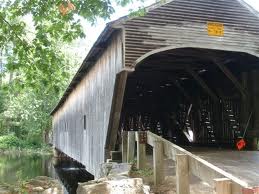Explore Bridges to the Past in the Lakes Regions of Maine

Out and About for the Sebago Lakes Region of Maine June 16-22
June 15, 2011
Out and About for the Belgrade Lakes Region of Maine June 23-29
June 23, 2011Explore Bridges to the Past in the Lakes Regions of Maine


Hemlock Covered Bridge over the old course of the Saco River, Fryeburg, Maine
by Leigh Macmillen Hayes
While searching for a lakefront property vacation home in the Lakes Regions of Maine, take some time to explore our covered bridges, like Hemlock Bridge in Fryeburg. Originally there were 120 covered bridges scattered across the state. Fire, floods, ice and progress contributed to the demise of all but nine.
During the 19th century bridges were covered for a couple of reasons. The roof kept rain and snow off the floorboards constructed of virgin timbers, thus helping to prevent rot. And . . . look at the entrances and you’ll notice a barn-like resemblance. Horses were easily spooked and did not like to cross rushing water that they could see and hear. The intention was to make them feel like they were entering a barn.
Covered bridges were known as Kissing Bridges in the 1800s because timid suitors would steal a kiss from their dates before their horse and buggy passed thru. Sometimes they stopped to carve their initials into the bridge timbers.
Today, the remaining covered bridges in Maine remind us of a time when life seemed simpler and closer to the land. They symbolize that small-town America feeling that seems to have passed us by in the twenty-first century. All nine are listed on the National Register of Historic Places.
One of the oldest bridges built in the state was Lows Bridge. It crosses the Piscataquis River between Guilford and Sangerville. The original bridge was swept away by spring floods, most recently in the April Fools Day storm of 1987. A modern bridge, patterned after the original, was constructed in 1990. Lows Bridge is located off Routes 6 & 15.
Babb’s Bridge spans the Presumpscot River in South Windham. Located off River Road, the original bridge was burned by vandals in 1973, but an exact replica of the one span Queenspost truss was erected and opened to traffic in 1976.
Hemlock Bridge, off Route 302 in Fryeburg, spans the old course of the Saco River. Built in 1857, it’s one of the earliest examples of the Paddleford truss construction strengthened with laminated wooden arches. Hemlock Bridge was reinforced in 1988 to carry local traffic. In January 2002, it was designated as a Maine Historic Civil Engineering Landmark by the American Society of Civil Engineers.
Built in 1859 by both towns was the Parsonsfield-Porter Bridge. The 152-span over the Ossipee River is another example of the Paddleford truss strengthened with laminated wooden arches. Located off Route 160, this bridge was closed to vehicular traffic in 1960.
Also built with Paddleford trusses is the Lovejoy Bridge across Ellis River in South Andover. At 70 feet long, Lovejoy Bridge is Maine’s shortest covered bridge. Built in 1867, the bridge was reinforced in 1984 to carry local traffic. It’s located off of Route 5.
A bit longer is the Sunday River Bridge in Newry. This 87-foot Paddleford truss construction was built across Sunday River in 1872. It was closed to vehicular traffic in 1958, but is known as Artists’ Covered Bridge because of its reputation as being the most photographed and painted of all the bridges. It’s located off Routes 2 and 26.
The only surviving completely wooden shingled covered bridge in the state is the Robyville Bridge in Corinth. Constructed between 1870 and 1872, there is a discrepancy as to the sort of trusses used to span the Kenduskeag Stream. Some believe it to be a Long truss design, while others say it is an example of the Howe design. In 1984, the bridge was reenforced to carry local traffic and is located off Route 15.
The fourth example of Paddleford truss design is the Bennett Bridge, which spans the Magalloway River in Lincoln Plantation. Built in 1901, it has a total length of 93 feet. Bennett Bridge is located off Route 16 and was closed to vehicular traffic in 1985.
The youngest covered bridge in the state was built in 1911. Watson Settlement Bridge is located the furthest north, off Route 1 in Littleton, where it crosses over Meduxnekeag Stream. Two spans of Howe-type timber trusses span a total of 170 feet. The bridge was closed to vehicular traffic in 1984, but is designated as a Maine Historic Civil Engineering Landmark.
After you’ve explored some of these covered bridges and maybe even stolen a kiss, check out all the current lakefront real estate listings in Fryeburg by clicking on the box below.
